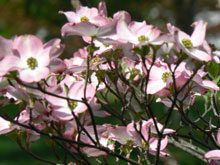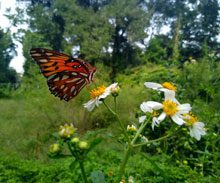Asters are named for stars, and these groups of the Compositae family are stars of roadside and garden. The genus, Aster, includes daisy-like flowers from Europe. There are approximately 75 species of North American Asters that were given that genus when they were first discovered and described by taxonomists. Recently, they have been reclassified and given unpronounceable names because they do not have the same DNA as their European cousins. We can still call them asters or daisies, and common names like Christmas Daisy or Fall Aster will keep us smiling through the seasons.
Mint is another useful and beautiful family found wild and cultivated for herbal teas, attracting beneficial insects and showing lovely blooms. “Heal-all” or Prunella vulgaris is a low growing herb found in moist shady soils. The dark purple and lavender flower has a mouth and a throat. The leaves are boiled and the water used as a gargle or mouth wash. Another one of the mints is Monarda. This wildflower attracts pollinating insects and hummingbirds with tubular pink or red flowers and the leaves can be steeped for a minty tea.
Plants that are named for animals usually have names describing a use or characteristic of that plant. Spiderwort, lousewort, dogwood, lion’s tail, leopard’s bane, catnip, mouse eared chickweed, and horsetail are just a few. Historical and regular people are namesakes of wildflowers, and we also give ourselves floral names like Rose, Daisy, and Violet. Folklore tells the story of Joe Pye, a tall medicine man, who prepared Eupatorium sp. as a tonic to treat colonists who had come down with a fever. The Joe Pye weed may be found growing in fields and ditches, six feet tall with beautiful lavender clusters of flowers resembling a head. Black eyed Susan, Sweet Betsy, Venus’ Looking Glass, and Jack in the Pulpit are other wildflowers with people names. Religious and irreligious plant monikers like St. John’s Wort, St. Andrew’s cross, Cross vine, passion flower, Devil’s paintbrush, devilwood, and Devil’s Walking Stick should impart a feeling about the plant and also something to remember it by.
Many native and introduced herbs are given credit for healing properties, and their usefulness – or the belief that they are useful – will continue. For every human condition, from hair follicle to toenail, some plant has been used as a dietary supplement, cosmetic, or treatment. While some plants may be curative or beneficial, others contain toxic or fatal compounds. Names like Deadly Nightshade and Fly Poison speak volumes. Every culture has its traditional plant-based medicines and terminology for the good and evil that can result from nature’s pharmacopeia.
Whatever the weed, wort, or herb’s name, there is a reason for its existence and its place in an ecosystem. Diversity is nature’s strong suit; we can admire the beauty of a field of wildflowers and swear at those same flowers when they’re in the front lawn. I have a lot of respect for any plant that can produce thousands of seeds or come up through asphalt, weed cloth, and concrete. Tenacity and success of our wild herbaceous friends can be a metaphor of life, and Beauty is in the eye of the beholder.
Plant identification is not always easy. Common names may vary from one location to another. Anecdotal reports of cures and remedies are all over the internet. Do not eat or use any plant without a positive identification. Even field guides are not reliable enough to risk injury or worse. Experience and study of ethnobotany are lifetime pursuits.
To find out more about South Carolina wildflowers and native plants visit the Clemson Home and Garden website http://www.clemson.edu/extension/hgic/ or visit the South Carolina Native Plant Society Website http://www.scnps.org/ and explore links to other states’ groups and resources.









